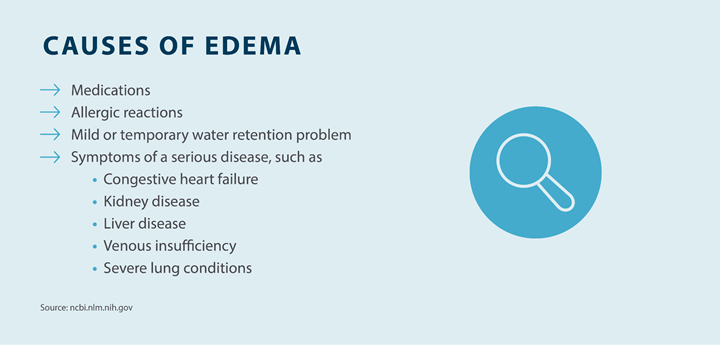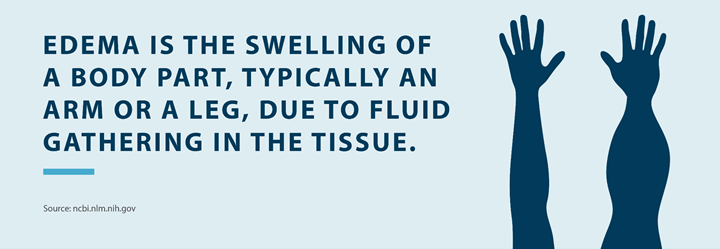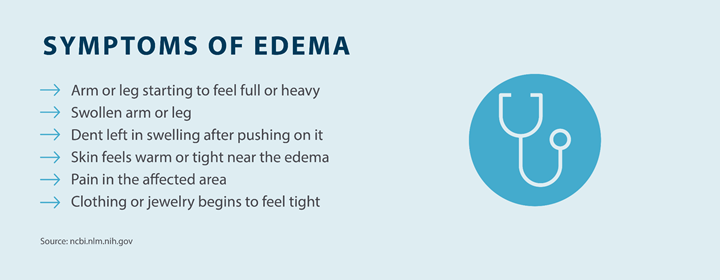Lymphedema and Weight Loss
Living with lymphedema while trying to manage your weight can feel overwhelming, but understanding the connection between lymphedema and weight loss can help you develop effective strategies for both conditions.
Read More

If you’ve ever experienced swelling in your body, whether it be your ankle, leg, or arm, you may have edema. Edema is the medical term for swelling, and it can be caused by a number of factors, such as a disease, medication, or allergy.
Not only can edema be painful and uncomfortable, but it can also lead to further health complications if it’s not properly treated, which is why it’s crucial to find the proper treatment for your swelling, wherever it may be.
In this blog post, we’ll define edema, as well as its causes, treatments, and more.
Edema refers to the swelling of a body part that is caused by fluid trapped in your body’s tissue. It’s most common in the legs and arms, but it can occur in any part of your body. The swelling can be small, or it can affect your entire body. It can last just a few days in response to an injury or for months.

Edema occurs when your small blood vessels leak fluid into surrounding tissues. When that extra fluid builds up, it causes swelling. This swelling can be uncomfortable and can make doing your regular daily activities more difficult.
Edema can be caused by a number of things, so it’s important to identify the root cause of your swelling to get a proper diagnosis and find the proper treatment.
You can experience edema if you fall and twist your ankle, or if you get stung by a bee. This edema will resolve as you heal. But ongoing (chronic) edema can have more serious causes. It’s important to see a doctor if your swelling persists so that you can properly identify what’s causing your symptoms.
Some of the most common causes of edema include:

There are also certain risk factors that can make someone more susceptible to edema. For instance, pregnant women are more likely to experience swelling as pregnancy causes your body to retain more sodium and water than usual. High blood pressure medications, nonsteroidal anti-inflammatory drugs, estrogens, or steroid drugs can also contribute to edema. Additionally, venous diseases, such as chronic venous insufficiency and deep vein thrombosis, can lead to swelling of lower extremities like the feet, ankles, and lower legs. Identifying the symptoms of edema can help you get the treatment you need, which we’ll explore in the sections below.
Edema symptoms differ for everyone and depend on the location and severity of the swelling. This swelling can be small and only on one part of your body, or it can span across your entire body.
These are some of the most common symptoms of edema:

The symptoms associated with edema can be uncomfortable, painful, and affect your daily life. If you’re experiencing any of the symptoms, it’s important to consult with your doctor. While it’s possible that edema can go away on its own, it can also worsen with time. Keeping track of any symptoms you have and documenting their progression can help your doctor make an accurate diagnosis.
In order to treat edema, you first have to identify the underlying cause. Since various circumstances can cause edema, treating it is not a one size fits all situation. A doctor will have the best advice for treating your edema.
In general, if you’re suffering from any type of edema, you should protect the affected area from injury and extreme temperatures.
Treating edema also depends on what type you have. For example, if you suffer from lymphedema, a type of edema caused by damage to the lymphatic system, multiple lymphedema treatment options exist. Lymphedema can be quite debilitating and painful, and can even lead to serious skin conditions if it goes untreated. It’s important to find the right lymphedema treatment solutions to reduce the swelling in your body.
At Tactile Medical, we offer lower and upper body lymphedema solutions. These garments can be prescribed by your doctor and used in the comfort of your home, allowing you to manage symptoms like pain and swelling. Additionally, your doctor or lymphedema specialist might suggest other management solutions, such as:
At Tactile Medical, we also offer head and neck lymphedema treatment solutions should you experience swelling in these areas of your body. Our lymphedema pumps and garments are doctor-prescribed and great alternatives to medication or surgery, as they can be used right at home.
Additional treatment options include manual lymphatic drainage (MLD), which is a massage technique that uses a series of hand motions to shift fluid from congested and swollen areas to functioning lymphatic regions, all while adhering to recognized anatomic and physiological principles. However, MLD depends on patient technique and ability, which is why at-home solutions like lymphedema pumps are often recommended. Pneumatic compression devices, known as lymphedema pumps, help the flow of lymphatic fluids to reduce pain, swelling, and discomfort.
If edema is left untreated, it can cause difficulty walking, stiffness, and increased painful swelling. It can also lead to an infection in the swollen area, scarring between the layers of tissue, and an increased risk of skin ulcers. It’s always recommended to consult with a doctor should any signs and symptoms of lymphedema arise so you can get a proper diagnosis and treatment plan.
There are several types of edema, with each affecting different body parts and requiring different treatments. In order to properly treat your edema, your doctor will determine what type you have.
The different types of edema include:

Lymphedema
Lymphedema is a type of chronic edema that results from an accumulation of lymph fluid in the body. Swelling from lymphedema is usually found in the arms or legs and can cause pain and discomfort in the affected limb. Primary and secondary lymphedema are two types of lymphedema. Primary lymphedema is due to improper formation of the development of the lymphatics prior to birth, which can be spontaneous or inherited. Secondary lymphedema develops after birth as a result of an injury or disruption to a once healthy lymphatic system, and the latter is caused by an injury or a disruption to the lymphatic system.
To diagnose lymphedema, doctors will often review patient history and conduct an examination. However, your doctor may decide to use other tests to provide imaging of a patient’s venous and lymphatic systems, typically ultrasound. In some cases, providers may also use CT or MRI scans, NIRF lymphatic imaging, or lymphoscintigraphy.
While there is no cure for lymphedema, several treatment options can help manage the symptoms. Such treatment options include Tactile Medical’s Flexitouch Plus system, which stimulates the lymphatic system to provide an easy way to manage lymphedema and non-healing venous ulcers from home.
Lipedema
Lipedema is a type of edema that occurs in both legs. Lipedema is often confused with lymphedema because both medical conditions involve swelling of extremities. However, lymphedema is a lymphatic system disorder where the flow of lymph fluid is disrupted and primarily occurs in the upper or lower extremities. On the other hand, lipedema is caused by the accumulation of fat deposits in the lower extremities, typically the legs, rather than a disruption to the lymphatic system.
However, treating and managing the symptoms of lipedema is relatively similar to the treatment options for lymphedema. Pneumatic compression devices can help improve drainage and reduce swelling, and certified therapists can conduct manual lymph drainage, a massage technique, to reduce inflammation, pain, and swelling.
Phlebolymphedema
Phlebolymphedema is caused by chronic venous insufficiency that eventually overwhelms and damages the lymphatics. When your lymphatics are damaged, they have difficulty draining fluids, which leads to phlebolymphedema. Symptoms of phlebolymphedema include swelling of the feet, ankles, and lower legs, as well as skin changes and ulcers.
Family history, trauma, blood clots, pregnancy, and inflamed veins are all potential causes of phlebolymphedema, along with lifestyle factors like smoking and lack of exercise. Certified lymphedema therapists can provide treatment options and at-home management solutions, such as decongestive therapy, compressive bandages, lymphatic pumps, and exercise routines to promote lymphatic drainage.
Cerebral edema
Cerebral edema is swelling of the brain. This type of swelling can be a result of head trauma, reduced blood supply, or brain damage.
Common symptoms of cerebral edema include headaches, neck pain or stiffness, vision loss, nausea, vomiting, or dizziness. Cerebral edema can be life-threatening if it goes untreated, so if you experience any of these symptoms, see your doctor immediately.
If you suffer from cerebral edema, it’s crucial to prevent any further injury in that area. In order to treat cerebral edema, you have to target the underlying cause. Treatment can include hyperbaric oxygen therapy, medication, IV fluids, or in severe cases, surgery.
Macular edema
Macular edema is the build-up of fluid in the macula, which is located in the center of the retina. This part of the eye enables detailed, sharp vision, so someone with macular edema will likely experience distorted vision.
The main symptom of macular edema is blurriness near the center of your vision. This can range from slight blurriness to noticeable vision loss. It can affect one or both eyes.
There are various ways to treat macular edema. The most common is intravitreal injections, which is when medicine is injected into the vitreous gel with a needle. Other treatment options include corticosteroids, NSAIDs, or a vitrectomy, which is a surgery to remove the vitreous gel.
Periorbital edema
Periorbital edema is puffiness or inflammation around the eyes due to fluid build-up. The cause of periorbital edema can be from an infection, tumor, medication, surgery, or trauma.
Periorbital edema is typically temporary, but there are a few things you can do to reduce swelling. This includes reducing your salt intake, drinking more water, using a cold compress, applying corticosteroids, or taking anti-inflammatory medication.
Peripheral edema
Peripheral edema is a swelling that can affect the feet, ankles, legs, hands, and arms. There are various causes of peripheral edema, such as heart failure, liver failure, pregnancy, or burns.
Symptoms of peripheral edema typically include swelling, puffiness, and difficulty moving certain parts of the body.
Depending on the severity and cause of your edema, there are several ways to treat it. If the edema is caused by lifestyle conditions, you can try elevating your legs, exercising, massaging the affected area, or wearing compression socks to reduce swelling. For more serious cases, other treatment may be recommended, so it’s important to see a doctor for an accurate diagnosis and treatment plan.
Pitting edema
Pitting edema occurs when an indent or pit is left on the skin after pressure is applied to the affected area. Pitting edema can occur as a result of poor circulation, dehydration, pregnancy, high blood pressure, diabetes, or numerous other causes. Pitting edema can also be a side effect of certain medications.
Certain factors can increase a person’s risk of developing pitting edema, such as a sedentary lifestyle, high sodium diet, thyroid conditions, and heart disease. You can treat pitting edema by elevating the swollen body part, wearing compression socks, taking diuretics to flush out excess fluids, and reducing your salt intake.
Pulmonary edema
Pulmonary edema occurs when there is an abnormal build-up of fluid in the lungs, which can lead to shortness of breath. Pulmonary edema is most commonly caused by congestive heart failure, which is when the heart is unable to pump efficiently, causing blood and fluid to build up in the lungs.
Pulmonary edema can also be caused by certain medications, kidney failure, high altitude exposure, or serious injury. If it goes untreated, pulmonary edema can be life-threatening.
The first way to treat pulmonary edema is to supplement oxygen through a face mask or nasal cannula. You may also be prescribed medications, such as diuretics, morphine, or blood pressure drugs to alleviate symptoms. If you experience pulmonary edema as a result of a heart condition, it’s important to make certain lifestyle changes. Try to keep your blood pressure under control, exercise, eat healthy, and avoid smoking.
Swelling in the body can be a sign of an underlying health condition. If you’re experiencing edema in any area of your body, it’s important to find the proper course of treatment to manage your symptoms. Finding treatment as soon as possible can help prevent the progression of symptoms, such as skin fibrosis and infections.
If you have swelling in your arms, legs, or torso, for example, keep note of your symptoms, how often they occur, and if anything triggers them. Providing your doctor with this information can help them determine the root cause of your edema and what the proper course of treatment is right for you.
At Tactile Medical, we offer at-home solutions for lymphedema, lipedema, and phlebolymphedema that can help you manage your symptoms and get your life back. Talk to your doctor about which solutions are best for you.
Living with lymphedema while trying to manage your weight can feel overwhelming, but understanding the connection between lymphedema and weight loss can help you develop effective strategies for both conditions.
Read More
Stage three lymphedema is the most advanced stage of this chronic condition. In this stage, the affected body part might display one or more symptoms, such as significant swelling, alterations in the skin, or recurring episodes of infection. While this stage can be challenging to manage, understanding your condition and...
Read More
When the lymphatic system becomes compromised, fluid buildup can lead to stage 1 lymphedema, a condition marked by mild but noticeable swelling in affected areas. This initial stage is a crucial window for intervention, as proper treatment can prevent progression to more severe stages. Knowing the signs, causes, and treatment...
Read More
Living with stage 2 lymphedema brings unique challenges, but understanding your condition is the first step toward effectively managing it. While this stage marks a point where the condition becomes irreversible, there are many ways to maintain your quality of life and prevent symptoms from progressing. Keep reading to explore...
Read More
Call us at 1.800.575.1900